Cards In This Set
| Front | Back |
 What is happening on this vase? |
On side A, Herakles is fighting the Libyan giant Antaios.
On side B, a youth is stepping up onto a platform about to play a flute. |
 What are the innovations shown on this vase? |
-Greater attempt to show emotional realism; pain, despair and anguish are clearly visible.
-Muscles are now rounded and bulge realistically. -Experimenting with different ways of showing figures: the giant's legs is the first true attempt at foreshortening. |
 What are the artistic features of this vase? |
-Herakles and his supporters are contrasted with Antaios and his supporters. The Greeks are neat and civilized.-Herakles' equipment is mirrored by the 2nd supporter of Antaios.
-The figures of Herakles and Antaios form a central triangle which is framed and extended into a W shape by the two females. |
 1) What shape is it?2) What is it for?3) Who made it? Who painted it?4) What style is it?5) When was it made?6) How big is it?7) What inscriptions are there? |
1) Calyx Krater
2) Mixing wine and water at symposiums. 3) The potter is unknown. It was painted by Euphronios. 4) Red Figure 5) 510 - 500 BCE 6) 46cm 7) The figures are named in purple glaze and it is signed by Euphronios. |
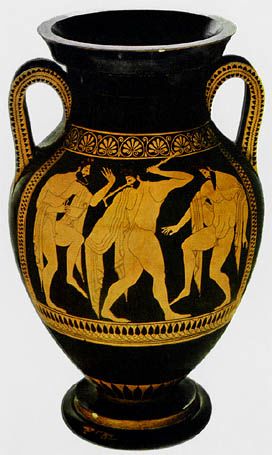 What is happening on this vase? |
On side A, three drunken revelers are returning from a symposium.
On side B, King Priam assists with his wife Hecuba as Hector arms for the Trojan war. |
 What are the artistic features of this vase? |
-Shoulder contours of figures follow shoulder contours of the vase.-Continuous fluid lines give more impression of volume than black figure.
-Incising around hair -Dark glaze gives an allusion of volume and depth -Euedemos is in an unusual pose which shows he's not in a stationary position.-Foreshortening is used in the feet.-Hector's helmet disrupts the upper band of decoration |
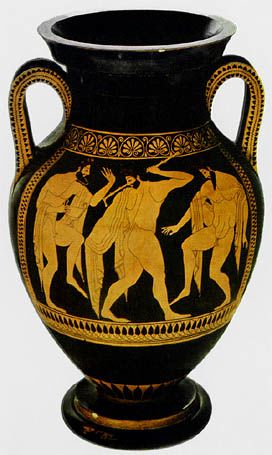 1) What shape is it?2) What is it for?3) Who painted it?4) What style is it?5) When was it made?6) How big is it?7) What inscriptions are there? |
1) Belly Amphora.
2) Storing liquids, wine, oil, honey, etc. 3) Euthymides. 4) Red Figure (Pioneer group). 5) 510 - 500 BCE. 6) 60cm. 7) "As never Euphronius (could do) + characters. named in purple. |
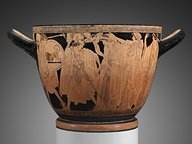 1) What shape is it?2) What is it for?3) Who painted it? Who made it?4) What style is it?5) When was it made?6) How big is it?7) What inscriptions are there? |
1) Skyphos.
2) A drinking cup. 3) Makron painted it, Hieron made it. 4) Red figure. 5) 490 - 480 BCE. 6) 21cm. 7) Figures named in purple. |
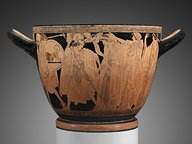 What is happening on this vase? |
- The abduction of Helen (side A).- Menelaos, the King of Sparta, is reclaiming Helen after the Trojan War (side B).
|
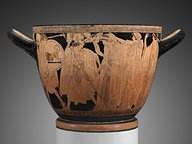 What are the artistic features on this vase? |
-Eyes are still painted frontal when head is in profile.
-Robes are more realistic; the cloak between Paris' leg ends in a "?" shape.-Paris' legs are wide apart to show he is moving with urgency. -Eros, Aphrodite and the maid-servant, Peitho (persuasion), show Helen was seduced not kidnapped but Paris holds Helen's wrist showing it was not entirely voluntary.-Overlapping and Eros' size and location give an impression of depth. -Paris, Helen and Aphrodite form a central square which Aeneas and Peitho frame.-The masculine, open and moving Paris and Aeneas are contrasted with the tight, static, feminine group. |
 1) What shape is it?2) What is it for?3) Who painted it? Who made it?4) What style is it?5) When was it made?6) How big is it?7) What inscriptions are there? |
1) Pointed Amphora.
2) Storing wine, oils, olives, etc. 3) The Kleophrades Painter / Kleophrades. 4) Red Figure. 5) 500 - 490 BCE. 6) 56cm. 7) Potter's signature. |
 What is happening on this vase? |
-Dionysus stands among reveling satyrs and maenads (side A).
-A satyr is playing a double flute (side B). -Three athletes taking part in various activities (neck) |
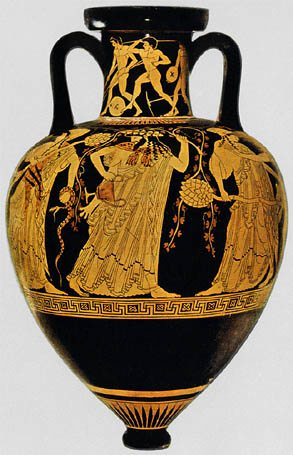 What are the artistic features of this vase? |
-The Himation flows behind the Maenads to show movement.-The Chitons are thin and show outlines of the bodies under them.-Eyes are frontal and show a trance-like state.-Mouths are open as if singing or calling out (next to two maenads "beautiful" is inscribed [male and female form respectively])
-Posture gives a mood of ecstasy, eg a maenad has her head thrown back, arms are away from the body as if swinging.-Clothing sways with the movement. -There is a degree of symmetry on around the two friezes on the neck. |
 1) What shape is it?2) What is it for?3) Who painted it? Who made it?4) What style is it?5) When was it made?6) How big is it?7) What inscriptions are there? |
1) Hydria.
2) Used for carrying water. 3) The Kleophrades Painter / Kleophrades. 4) Red Figure. 5) 500 - 480 BCE. 6) 45cm. 7) None of the figures are named. |
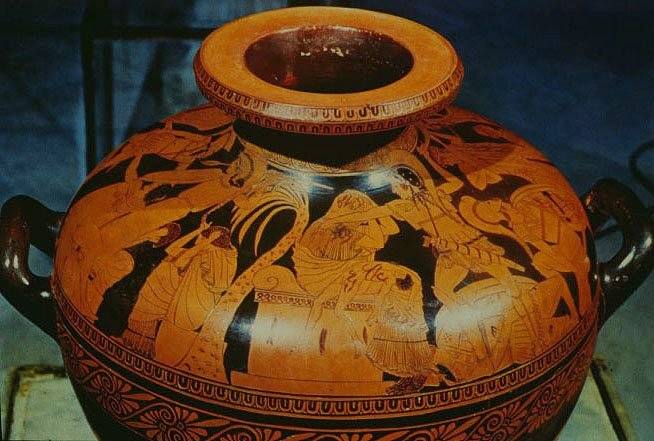 What is shown on this vase? What are the moods of each? |
The vase shows six "triangular" scenes.1) Aeneas fleeing with Ascanius and Anchises (hope).
2) The rape of Cassandra (cruelty).3) Crouching Trojan women (despair / powerlessness) 4) The murder of King Priam (cruelty) 5) A Trojan Woman fighting back (bravery)6) The rescue of Aithra (liberation) |



